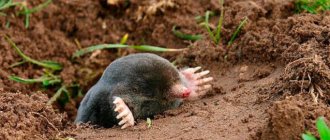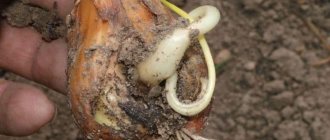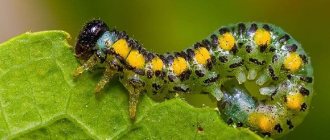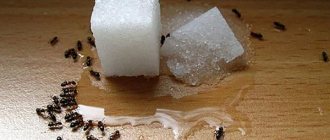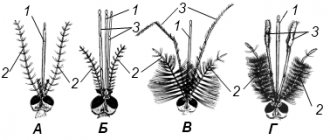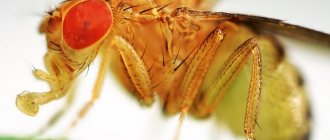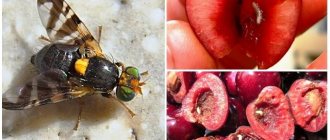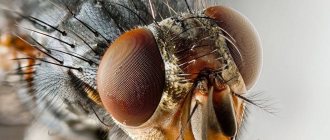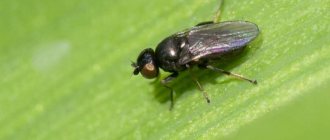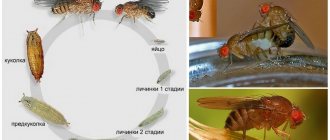Description and life cycle of onion fly
This is a very small, but very nasty insect, at first glance it resembles a common housefly. It reaches only 6-8 mm in length, has a yellowish-gray color, and in males there is a clear dark stripe on the abdomen. At the edges of the wings there is a fringe of thin hairs of different lengths.
The onion fly (Delia antiqua) is distributed throughout Russia, Asia, Europe and North America.
Larvae are responsible for damaging crops, but this does not mean that adult flies are not dangerous. They reproduce in large numbers, so you need to fight them all.
The pest wakes up in the first month of spring and flies out of the soil at the end of May. Adults lay eggs either in the ground or directly on vegetables. At a time - from 4 to 30 white oblong eggs, and after 5-10 days legless larvae appear. Having emerged from the pupae, the offspring begin to actively search for food and first eat the husks and then the pulp of vegetables. After 3-4 weeks, the larvae lay their offspring and pupate, then adult flies emerge. In seasons with moderately warm weather and sufficient rainfall, the garden may be subject to not just one pest attack, but 3-4. The onion fly goes into the ground for the winter.
Fighting methods
After making sure that an onion fly has appeared, they choose a method to get rid of the parasite. Even if part of the crop has already died, we must fight. After all, having overwintered, the next year the pest will again take up the crops grown with such difficulty.
Chemical preparations for onion flies are used when the task is not to save the crop, but to destroy the insect. If there is still hope of collecting the remains of the onion, gentle preparations from improvised means are used. Chemistry is not suitable in such cases, because the vegetable will accumulate poisons and become unsuitable not only for the larvae, but also for humans.
Traditional methods
Folk remedies for exterminating onion flies and their offspring are a wealth of experience plus effectiveness. After all, the competition between people and parasites for the harvest has been going on for centuries. Whatever homemade preparation for onion flies you choose, the timing is more important: the sooner the pest is detected, the more successful the treatment result. Therefore, regular inspection of plantings is mandatory, especially if the insect has already been noticed on the site in previous seasons.
Once faced with an onion problem, gardeners are proactive, trying to scare away the insect from the beds during a mass flight:
- Pour a little water (up to half a glass) and a spoonful of vinegar essence into low, wide containers (for example, a plastic bottle cut lengthwise). Strong fumes will scare away flies.
- For the same purpose, kerosene, turpentine, and tar are dripped into the soil between the rows and around the plants.
- Mixture - ash + tobacco dust + ground pepper (1 cup: 1 cup: 1 tbsp. L) - dust the feathers and soil around the plants.
- Scatter a mixture of ground naphthalene tablets and sand over the bed.
- Mulching with fragrant herbs (wormwood, tansy, mint, tomato tops, lovage greens), pine needles or watering with infusions of these ingredients.
Important! All of the above methods are effective if treatments begin before the start of mass flights and are carried out regularly after several days, alternating repellent compounds. In order not to be late, they are guided by the cherry: a few days before its flowering, the beds with onions and garlic should already be processed.
Watering onions with ammonia to prevent onion flies.
If there were no preventive measures or they were untimely (the fly managed to lay eggs), the following methods are used:
- Three times after 2 weeks, use a solution of ordinary salt (first 1 glass, then 2, third time - 3) in ten liters of water. The first treatment is when the feather extends to 5-6 cm. 200 ml of solution is poured under each root. The product is effective, but before you water the onions with salt to get rid of the onion fly, it is worth considering: on already saline soils, this measure is dangerous for the soil. At the same time, you need to add ingredients that shift the balance towards acidity. On neutral and acidic soils, it is enough to water the beds with plain water after a few hours or the next day.
- Watering onions with ammonia is a proven remedy for onion flies. There are several recipes based on this pharmaceutical drug: 2.1 Water, ammonia (10 l: 60 ml) - watering the beds at the root. If you add only 2-3 tablespoons of ammonia water to the same volume of water, the feather is sprayed to repel the pest with the smell. 2.2 Water, ammonia, salt (10 l: 5 ml: 1 tbsp) - water the beds at the root. 2.3 Water, ammonia, boric acid, iodine (10 l: 20 ml: 5 ml: 3-4 drops) - water the beds at the root.
- Another pharmaceutical drug, Metronidazole, is used once for irrigation. The goal is to destroy the larvae. At the stage when the feather has reached 5 cm, dissolve 5 tablets per bucket, if the feather is already up to 10 cm, then 8-10 tablets. Later use is not recommended.
- Potassium permanganate has long been bought not in pharmacies, but in country stores: the product has proven itself to be an effective fungicide and insecticide. Onion beds are watered with a bright pink solution.
A pest such as the onion fly forces you to fight it with folk remedies, so as not to kill the crop along with the insect. But still, these measures are precautionary in nature: at the stage when the feather is only 5-10 cm, signs of damage are not yet visible. But such means of control cannot be neglected; it is better to treat them 2-3 times with agents that are not dangerous to the soil and plants, than to then eradicate the crop along with the parasites.
Chemical method
Among the chemicals that can be used to treat onion fly beds, the following insecticides are recommended:
- Zemlin - scattered over the replanting mixture with sand, 2 mts are effective.
- The fly beetle is a poison with bait, dissolving from rains, waterings, and absorbed into the bulbs, so it is not used in beds where the crop is grown for feathers or in the second half of summer in beds with heads for storage.
- Inta-Vir – 2-3 times treatment with a two-week break. It is advisable to conduct the course in the first half of summer. Feathers and bulbs should not be consumed for 3-4 weeks after the last treatment.
- Alatar - no more than 2 treatments per season. Toxic.
- Creolin is used to destroy the pest without counting on the harvest. Extremely toxic.
When the parasite forced the use of chemicals, the manufacturer’s recommendations and safety measures should be strictly followed. If possible, do not poison the crop in the second half of summer: the accumulated poisons will not have time to be neutralized before harvesting. It is better not to treat green vegetables with chemicals at all, preferring traditional methods of control.
Signs of the presence of a pest in the garden
It is difficult to see the larvae, since they do not crawl to the surface of the soil unless absolutely necessary. But from the appearance of the plants, it is immediately clear what kind of pest has attacked your garden: the plants develop unusually slowly, their feathers turn yellow and wither, and they also begin to smell disgusting. The bulbs become soft and loose to the touch, and a rotten coating is noted. They cannot be eaten.
How to get rid of onion fly: effective remedies
Salt
An effective remedy for making the soil unsuitable for living of larvae and adult insects, as they are afraid of salt. But you need to be careful and not increase the dosage, otherwise the soil will become saline and plants will stop growing on it. You need to dissolve 200 grams of salt in 10 liters of water and water each bulbous plant at the root. Repeat watering once a week.
The remaining solution must be washed off! 5-6 hours after treatment, it is necessary to water the soil abundantly and wash off the solution from the above-ground parts of the plants.
Ash
Wood ash not only destroys onion flies, but also has a positive effect on the productivity of garden crops by fertilizing the soil. It's easy to get - just a few dry branches on the trees. The plantings are powdered between the rows, having previously moistened the soil. Repeat the procedure every 2 weeks from spring to autumn, covering the ash deeper with a hoe.
Tobacco dust
The onion fly cannot tolerate the aroma of tobacco, so the following advice is effective: scatter a package of tobacco dust (you can buy it at a gardening store) in small quantities between the onion beds during the season at intervals of 2 weeks (at the rate of 1 tablespoon of tobacco per square meter of area ). In addition to pure powder, you can also use mixtures, for example, tobacco, ground pepper and ash (in a ratio of 1:1:1) or tobacco and sand in similar proportions.
Sagebrush
Freshly harvested stems of this fragrant weed do not allow flies to linger in the garden for a long time: just lay them out between the beds and change them more often. You can prepare a solution according to the following recipe: finely chop a kilogram and a half of fresh wormwood, add 10 liters of cold water and leave to infuse in a dark place for 2-3 days. Afterwards, strain the infusion and water the beds with it. It is enough to use the product once every 2 weeks.
Carrot
The idea of planting onions and carrots side by side is good, but it has one significant “minus”: the onions must be left to ripen in the soil before harvesting, while watering is completely stopped for 2 weeks, and carrots, which love moisture, rarely withstand such a test without loss. Experienced gardeners recommend a trick: planting crops side by side, but not across a “line,” but dividing the bed lengthwise and planting 4 “lines” of each vegetable on each side. The carrots will have enough moisture, it will be possible to dry the onions, and the flies will not touch either one or the other crop.
Marigold
The second name is tagetes, which produce the same effect on the pest. Low varieties are excellent: they can be planted around the perimeter of the onion plot, or you can mark out transverse grooves for flowers inside the bed while planting the sets. Alternate them through 2-3 onion “lines”.
Pine needles
The onion fly cannot stand the smell of pine needles (both fresh needles and old opal). After the first shoots appear in the onion bed, you need to properly mulch the soil with pine needles. After such manipulations, pests will not risk laying eggs on the site.
If you are late with mulching, you can make an infusion from pine branches. The scheme is like this:
- Place 1/3 of finely chopped young pine branches into a bucket.
- Fill them with hot water to the top of the container.
- Cover with a lid and leave to infuse for 4 days.
- Strain the liquid and pour it over the rows of garlic and onions.
Naphthalene
Naphthalene saves not only fur coats from voracious moths, but also onions from the equally voracious onion fly. You need to crush 8-10 naphthalene balls, mix with sand (half a bucket is enough) and sprinkle the mixture over the plantings. This should be done every week in the summer.
Ammonia
Despite the cheap price, ammonia rids the garden of onion flies quickly and for a long time. Simply stir 3 tablespoons of ammonia in 10-12 liters of water and water the soil generously. The pest prefers to move away after the first procedure, but to consolidate the result, it is not a bad idea to water every 2 weeks. Since ammonia will act as a nitrogen fertilizer, all manipulations to get rid of insects should be completed before mid-June.
Kerosene is an effective means of combating onion flies. Pour 200 ml of the substance into half a bucket of sand and mix well. The mixture should be spread into onion rows every 10-12 days. At the same time, the crop will not be saturated with an unpleasant odor and the kerosene will not affect the taste in any way. But you need to work in thick rubber gloves, observing safety precautions.
LiveInternetLiveInternet
Natali-Natalka
all posts by the author
Onion fly - pictured
Again about the sore point, onion fly - how to fight it? What needs to be done to get rid of the parasite in the garden once and for all? The fight against harmful insects is carried out every year, but cunning summer residents know how to fight back and protect the onion harvest. Learn the secrets and basic methods of control, as well as methods of getting rid of folk remedies, insecticides and other drugs….
Every summer resident has at least once in his life encountered the appearance of an onion fly on his property. This small winged insect, no more than 7 mm, causes significant damage to the onion crop. What to do if there is an onion fly, how to fight it? What methods are most effective in combating this pest?
The onion fly is visually practically no different from the house fly, but is much smaller in size: its ash-gray body with a greenish tint on the back reaches no more than 5–6 mm in length. The pest appears in the spring, when dandelions and fruit trees begin to bloom.
If you don’t know how to grow large onions, then know that the onion fly chooses dried scales of bulbs as a place for laying, but if you can’t find any, it can lay eggs directly in the soil. The larvae are born literally after a couple of days - these are small white worms that infect almost the entire onion. In 2 weeks the plant is completely destroyed, they pupate, and by mid-summer the young onion fly is ready to destroy the crop!
onion fly
Note that the insect infects not only ordinary onions, but also bulbous plants - garlic and flowers with bulbous roots. The affected plant dies - both young shoots and adult parts begin to turn yellow and dry, the bulbs begin to rot, and a fungus appears.
If an onion fly was noticed on a personal plot, how to deal with it? How to keep bulbous plants healthy? Without carrying out preventive measures, you can forget about a good harvest. It is important to know that it is extremely undesirable to destroy this pest using pesticides. This is explained simply - the onion retains chemicals and insecticides quite well, in the future the vegetable will simply not be suitable for food.
onion fly is a pest
Not even all summer residents know what to do if an onion fly appears, or how to fight it. It turns out, like many parasitic insects, the pest does not like unpleasant odors. In this case, the smell of carrots and tomatoes is repulsive. Many housewives plant onions, alternating them with carrots, and create a bed of tomatoes nearby.
The effect of such plantings, as they say, is obvious - there are no onion flies or carrot flies, so joint plantings in this case will only be beneficial. Reviews from experienced gardeners about growing vegetables together are, in most cases, positive.
onions and carrots planted together to prevent onion flies - pictured
Spraying onions with strong-smelling decoctions of mint, valerian or pine needles will be effective. These decoctions are absolutely safe for plants. Another popular method of struggle is tobacco dust. This product is sold in retail outlets for gardeners. It can be scattered between the rows of onions or sprayed on the plants with a solution (the proportions are indicated on the package).
According to agronomists, the most effective method of killing onion flies is ammonia, which must be diluted in a proportion of 3 tbsp. l. per 10 liters of water and water the soil under the plantings. Repeat the procedure three times, at intervals of 7-8 days. Nitrogen, which is part of alcohol, also acts in this case as a fertilizer for onions.
Ash as a fertilizer is a very effective folk remedy in the fight against onion fly and its larvae - just sprinkle the rows with ash. By the way, our grandmothers also used ash, they successfully brewed it. Take part of the ash and pour three parts of boiling water, let it sit for a day under the lid, and then water the plantings - you will be surprised where the parasites go!
Among folk remedies, a tincture of dandelion rhizomes is quite popular among summer residents. 200 g of roots should be placed in a container and pour boiling water. Let it brew for a week. Water the beds with the solution once every 2 weeks.
Folk remedies for onion flies - pictured
Some people prefer to use regular table salt. The product is effective, but there is one significant drawback - the soil accumulates salt and becomes unfavorable for other plantings, so it is used once a year: dilute 250 grams in 10 liters of water and pour the onion under the root. After 3-4 hours, rinse well with clean water.
You are not mistaken, once a year will be enough. If you follow the advice on the Internet, where they write that you need to add a kilogram of salt to the soil in several stages per month, then you will simply destroy your land and after a couple of years of such skill, nothing will grow in your garden bed at all. You need to know moderation in everything!
Some farmers mix naphthalene with sand or ash in a ratio of 1:10 and sprinkle it on the plantings. One or two procedures are carried out during the summer of the onion fly and egg laying.
Another popular method is laundry soap. Dissolve a bar of soap in 10 liters of water and spray the plants with the resulting solution. In addition, potassium permanganate comes to the rescue again! Make a rich pink solution and water late in the evening to avoid burning the plants. Repeat the procedure if necessary, every 8-9 days. On the forum, according to reviews, many summer residents save onions from flies this way.
Prevention of the appearance and spread of parasitic insects, including onion flies, means creating an environment for them in which they cannot live and reproduce. First of all, you need to inspect the planting material. All bulbs must be intact, without any damage; even the slightest trace of rot should be a reason for rejecting the seedling.
Selected healthy bulbs must be treated before planting in the ground. You can do this in two ways:
Hot water - the onion is immersed in hot water (about 50 ° C) for 15 minutes, then dried well and planted;
Potassium permanganate - the solution is prepared in a proportion of 1 g/l of water. The onions are kept in the solution for 30 minutes, after drying they are ready for planting.
It is worth noting that processing onions before planting is an important and necessary step in growing vegetables if you want to grow a rich harvest. Unfortunately, many gardeners do not want to bother with seedlings and simply plant them in the ground, dooming their plantings to a guaranteed low yield.
onion fly larva - pictured
Deep digging of the soil at the planting site in the fall will also help get rid of onion fly larvae. The pest survives winter at a depth of no more than 20 cm, which means that when digging, all the larvae will move to the surface, where they will die at the first frost. Another important rule is to be sure to remove crop residues from the beds, as this will not provide a favorable breeding environment for the onion fly.
I have an onion fly in my garden, how can I fight it? - sellers of gardening stores often hear. In this case, you will definitely be recommended a drug such as Bazudin. 30 g of this product must be mixed with 0.5 liters of sand (can be replaced with sawdust) and poured into the ground. This must be done at the end of spring.
In addition, you can buy other drugs against onion flies - Fly eater, Diazinon, Dachnik, Medvetoks, Muraviin, Teradox and others. Don’t forget, if you grow onions for greens, some preparations cannot be used for processing. Fighting onion flies is much easier if you understand how to do it! It won’t take much effort and time, but in the fall you will definitely feel the results!
https://ogorodko.ru/lukovaya-mukha.html
How to destroy onion fly larvae: the best methods
The onion fly larva is a very persistent pest. It makes its way through the layer of husk inside the onion and devours it from the inside, and does not disdain either onions, leeks, or garlic. There are several ways to destroy them.
- Dig up the area after the fall harvest. This way the larvae will crawl to the surface of the soil, where they will freeze.
- Dilute 50 g of laundry soap in 10 liters of warm water and water the plantings.
- Sprinkle the ground with a mixture of naphthalene and fine sand (1:1)
- Buy anti-worm medicine at the pharmacy and dissolve 5 tablets in 10 liters of water. Water the soil with this solution once.
Have you tried killing onion moths with ammonia?
Yes
No
If folk remedies do not help, you should try fast-acting chemicals. The following drugs are especially effective:
- "Extraflor" is a biological preparation based on tobacco extract, which does not accumulate in vegetables;
- “Tarantula” - destroys both larvae and adult pests within 3 weeks;
- “Zemlin” - requires mixing with sand or sawdust;
- "Aktara" is a broad-spectrum insecticide, economical and fast-acting;
- “Dachnik” is a product based on fir oil, absolutely safe for humans, which is mixed in water along with a portion of green soap;
- “Fly-eater” is an insecticide in the form of aromatic granules that are placed in the soil and, having attracted the pest, slowly poison its body;
- “Bazudin” - helps get rid of adult onion flies during the egg laying period.
What does an onion fly look like?
Many representatives of the order Diptera are similar to each other, and you need to be an entomologist to be sure to recognize a specific species. Imagine an ordinary housefly, only smaller, about 5-7 mm long. If you want to get to know each other better, look for onion flies in the spring on dandelion or cherry flowers.
You can recognize the pest by its yellowish-gray body color and transparent wings with a bronze tint. Armed with a magnifying glass or high-quality photos of the onion fly, you will see black legs and fleecy bristles on the back.
Adult onion flies (imago) are real gourmets and do not feed on onions or garlic. Their food preferences include the sweet nectar of aster plants and stone fruit trees. But the onion and garlic aromas are extremely attractive to females, who flock to the beds to lay their eggs there. Therefore, it is important to study the developmental features of insects in order to understand how they spoil the crop.
Onion fly.
Onion fly.
Preventive methods against onion fly
A number of preventive measures will help, if not completely block pest access to the site, then significantly reduce the risk of parasites.
- Follow the rules of crop rotation. You cannot plant the same crop for several years in a row. If the pest settles in for the winter, then in the spring, immediately after awakening, it will begin to eat the plantings. Onions can be planted in the old place only after 4 years.
- The onion fly does not like the smell of carrots, and the carrot fly does not like the smell of onions. By planting them side by side, you can scare off two pests at once. Other plants can also help: lovage, wild rosemary, tomato.
- It is imperative to dig up the soil in the autumn months. This needs to be done deep, since individuals overwinter at a distance of 15-20 cm from the soil surface.
- Before work, planting material must be carefully inspected for infection with larvae. If they exist, even clean soil will not save it; you will have to throw it away. Bulbs untouched by the pest must be heated at a temperature of +25 degrees, soaked in a salt solution (a tablespoon per liter of water) for 3 hours, and then dipped in a solution of potassium permanganate for a couple of hours.
- A couple of times a month, water the area where garlic and onions grow with products that protect against onion flies. You can use folk remedies.
- Damaged and diseased plants must be immediately removed from the site and burned outside of it.
The onion fly can be difficult to spot in your area, so be extremely careful. You can deal with this winged pest quite easily, but it is important not to waste time and start solving the problem at the first sign of damage to the area. Existing methods - chemical, folk, agrotechnical - will allow you to preserve the harvest and get rid of the nasty insect quickly and without consequences.
Fighting onion fly with folk remedies
- Ammonia . In 10 liters of water dilute 3 tbsp. l. facilities. The soil needs to be watered with this mixture three times. It is necessary to maintain a gap of 7-9 days between such waterings. Ammonia contains nitrogen. Thus, the treatment will not only destroy the pest, but will also become an excellent fertilizer for the plant.
- Ash . It contains substances that repel not only adult pests, but also larvae. It is recommended to sprinkle the rows with ash. You can also prepare a composition for watering. Use three parts boiling water for one part ash. Cover the container with a lid and let the mixture sit overnight. After this, the mixture is ready for use.
- A tincture made from dandelion roots has become widely popular . To prepare the composition you will need 200 g of roots, which are poured with boiling water. The product should be infused for a week. It is recommended to water the beds with this mixture once every two weeks.
- Salt . For 10 liters of water, use 250 g of salt. The composition is poured under the root of the plant. After a few hours, it is recommended to water the bed generously with clean water. Such processing should be carried out no more than once a year. It is worth remembering that frequent treatments with salt lead to its accumulation in the soil. Thus, this area becomes unfavorable for growing other crops.
- Naphthalene . Take one part of this substance and mix with ten parts of sand. The plantings are generously sprinkled with the resulting composition. This treatment must be carried out twice: during the flight of the onion fly and during the egg laying period.
- Laundry soap . Grate the whole piece and dissolve in 10 liters of water. The resulting soap solution is used to spray the plant in the garden bed.
- Potassium permanganate . Prepare a saturated solution that waters the plants every week. This treatment should be carried out late in the evening. If watering is carried out in the midday heat, the plants will get burned.
( Video : “Onion fly. How to deal with it”)

